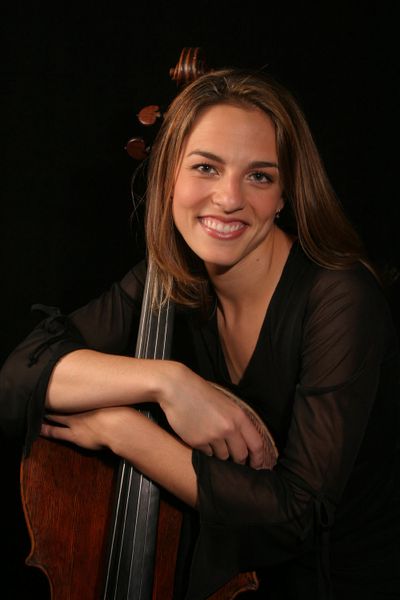Symphony offers pair of firsts
Cellist Julie Albers, Japanese piece make local debut

Spokane Symphony audiences will hear two debuts this weekend at the Martin Woldson Theater at The Fox.
The American cellist Julie Albers will make her Spokane debut playing a concerto by Joseph Haydn, and the orchestra will give the first American performance of Akira Nishimura’s “The Birds Heterophony.” Morihiko Nakahara, the orchestra’s resident conductor, will also lead Jan Sibelius’ Symphony No. 2.
Albers was born in Longmont, Colo., where she began studying violin with her mother when she was not quite 2. “I was the second of four children,” the cellist said in a telephone interview from New York during a rehearsal break. “Both my parents are musicians. My mother was a violin teacher. Since I was pestering my older sister Laura who was studying violin, Mom got me started on violin when I was 18 months just so my sister could get on with some productive practice.”
Albers switched to the cello at four. “Mom didn’t want me to be in competition with Laura, so for a while, she took me to a lot of cello recitals and there were lots of cello recordings being played at home, so my move to the cello seemed to be my idea.”
By the time she was a junior in high school, Albers moved to Cleveland to study cello with Richard Aaron as a part of the Cleveland Institute of Music’s Young Artists Program. “My sister was already at the Institute, so for my last two years of high school, she was my mom,” Albers says.
All three of the Albers sisters are professional musicians. The lone renegade is her younger brother. “He started in music, too,” Albers says. “But he switched to snowboarding. Now he’s in training to be a sushi chef.”
At 17, Albers made her debut with the Cleveland Orchestra playing Dvorak’s Cello Concerto. The same year, she won first prize in the International Competition for Young Musicians in Douai, France, and toured France with the Orchestre Symphonique de Douai. She later won international competitions in Germany and Korea.
Albers, now 28, lives in New York where she is in the final year of a three-year residency with the Chamber Music Society of Lincoln Center, and she teaches as a part of the artist faculty at Kean University in New Jersey. With her sisters, violinist Laura and violist Rebecca, she is a member of the Albers String Trio. And with three other New York-based cellists, she is a member of the CELLO quartet.
Albers will perform Haydn’s Cello Concerto in D major, a work Haydn wrote for Anton Kraft, Haydn’s cellist in Prince Esterhazy’s Orchestra. “What makes this concerto so special for me is that it is so lyrical, like someone singing but with that little Haydn-esque spark of wit and even little jazzy bits in the first two movements,” Albers says, “and in the finale is just pure fun – it’s fun to play and it makes you feel good.”
Nakahara opens this weekend’s Spokane Symphony concerts with Nishimura’s “The Birds Heterophony” written in 1993 for Ensemble Kanazawa, a Japanese chamber orchestra with whom the composer has had a long association. “Nishimura is one of the best-known composers in Japan today,” Nakahara says. “And he is even well-known in Europe, but he is not well known at all in this country.”
The technique of heterophony – the combining of several differently ornamented versions of the same melody simultaneously – has a long history of use in non-western music and in folk music. “This is a technique that is very much a part of Nishimura’s style,” Nakahara says. “And the use of bird song and sounds from nature, such as water, are things that fascinate many Japanese composers.”
The 55-year-old Nishimura was born in Osaka and was educated at Tokyo University of Fine Arts and Music. In 1977 he won what was to be the first of a long series of prizes when he was the recipient of Belgium’s Queen Elisabeth award for Composition and soon thereafter the Dallapiccola Award in Italy. He lives in Japan where he teaches composition at the Tokyo College of Music and is music director of the Sinfonetta Osaka.
Nakahara will conclude this weekend’s performances with Sibelius’s Symphony No. 2, written just a year after the composer had established himself as the Finnish composer by writing what would quickly become the country’s unofficial national anthem, “Finlandia.”
Sibelius’s works are so well-known and popular with classical audiences, it is easy to forget the sophisticated way in which he builds his symphonies. As the composer himself wrote, “It is as though the Almighty had thrown down pieces of a mosaic from the floor of Heaven and told me to put them together again.” So listening to the music assemble itself from those mosaic fragments is one of the great pleasures of experiencing Sibelius’s music.
Conductor Morihiko Nakahara and soloist Julie Albers will discuss the music of the program in pre-concert talks beginning one hour before curtain time at The Fox as a part of the Gladys Brooks Pre-Concert Lecture series.